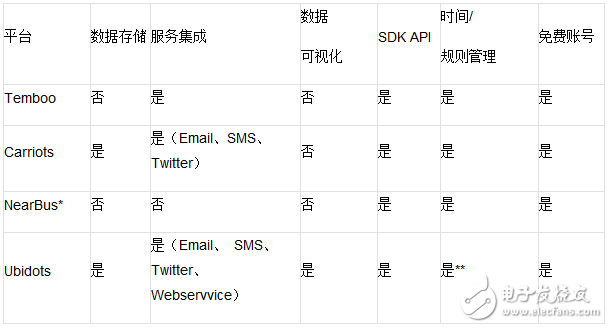With the continuous development of information technology and the continuous popularization of smart devices, we are gradually entering the era of the Internet of Things and realizing the vision of the Internet of Everything, from traditional sensor modules, refrigerators, televisions to health bracelets, smart glasses, etc. Devices can be connected through a variety of network protocols, and it is believed that in the near future, people can control these devices with their mobile terminals.
However, the Internet of Things brings convenience to people while challenging suppliers: in order to provide better services, they must integrate IoT devices and store and analyze the large amounts of data they generate. Most companies are unacceptable both in terms of technical difficulty and resource cost. Fortunately, today's cloud computing era provides a "free lunch". Recently, Francesco Azzola published "4 free IoT building platforms" on Dzone, introducing four very good IoT cloud platforms: Temboo, Carriots, NearBus and Ubidots.
Temboo
Temboo's software stack provides a number of pre-built processes for handling common problems with IoT applications, including monitoring, data logging, notifications, remote control, and more. The platform automatically generates custom product-level code and provides top-notch documentation and a fast-response support team that allows users to develop cutting-edge applications as they wish.
Temboo integrates its software library into the hardware development platforms of Texas Instruments, Samsung and Arduino, enabling it to easily integrate with a wide range of devices; Temboo integrates its data stream into leading cloud storage services, enabling users to Select and change the sending location of sensor data; Temboo supports MQTT, CoAP and HTTP protocols, presets more than 2000 APIs, supports more than 10 SDKs and multiple programming languages; in terms of security, Temboo supports TLS encryption, performance sandbox And features such as modular architecture.
Carriots
Carriots is a platform-as-a-service (PaaS) designed for IoT and M2M projects that enables users to build projects that are faster, cheaper, simpler, more reliable, and more scalable. Carriots supports many features, including device management, triggers, custom alerts, API key management, user management, debug logs, SDK application engine, listeners, Groovy script rules, data export, customer ratings, and custom dashboards. Wait. For these features, Carriots provides a REST API for users to call.
Carriots supports the Arduino and Raspberry Pi open source hardware platforms and supports the MQTT protocol. In addition, Carriots also provides a graphical API that allows users to easily integrate data charts into their own web applications.
NearBus
NearBus uses a different concept than the traditional IoT cloud platform, which "maps" IoT devices to the cloud instead of "connecting" to the cloud. The NearBus system maps a small portion of the microcontroller's memory to the cloud's memory. At this point, the user's read operation of the cloud memory affects the microcontroller as if it were reading the microcontroller's memory directly. This operation greatly simplifies the way the device is controlled.
NearBus has two main components, one is the remote device controller NearAgent, and the other is the cloud center manager NearHub. Essentially, NearBus is a cloud connector that allows users to integrate different MCU platforms (such as Arduino and OpenPicus) in a very simple and transparent way. As long as a lightweight agent (NearAgent) is installed on the MCU hardware, the user can view the state of the hardware through the NearBus system and control it through NearAPI (a very simple set of Web service APIs), which makes the user efficient and convenient. Control the IoT device, which greatly simplifies the development process.
Ubidots
Key features provided by Ubidots include data capture, analysis visualization, and rule management. All Internet-enabled devices can push data to the platform, including Arduino Modules, Raspberry Pi, Electric Imp, Spark Core, Microchip WCM, RN131/171 EK, and Android. In terms of visual analysis, Ubidots supports real-time dashboard functions, allowing users to display sensor data through custom components such as line charts, pressure gauges, multi-line plots, scatter plots, and maps, all of which can pass a common The URL is shared or embedded in an external web application or mobile application. After being embedded in an external system, the data of the chart will also change in real time. Finally, any IoT platform is inseparable from event reminders. On the Ubidots platform, users can easily configure what kind of alert should be triggered under what circumstances, including email, SMS or external Web services. It also provides great convenience to our users.
Finally, Francesco Azzola compares the main features provided by the above four IoT platforms in detail through a chart:

Features
â—† Designed For Water and Dust Tight(IP67)
â—† Small Compact Sizeâ—† UL&ENEC&CQC Safety Approvals
â—† Long life & high reliability
â—† Variety of Levers
â—† Wide Range of wiring Terminals
â—† Wide used in Automotive Electronics,Appliance and Industrial Control etc.
â—† Customized Designs
Subminiature Dustproof Micro Switch
Micro Magnetic Switch,Micro Momentary Switch,Sealed Rotary Switch,Subminiature Dustproof Micro Switch
Ningbo Jialin Electronics Co.,Ltd , https://www.donghai-switch.com